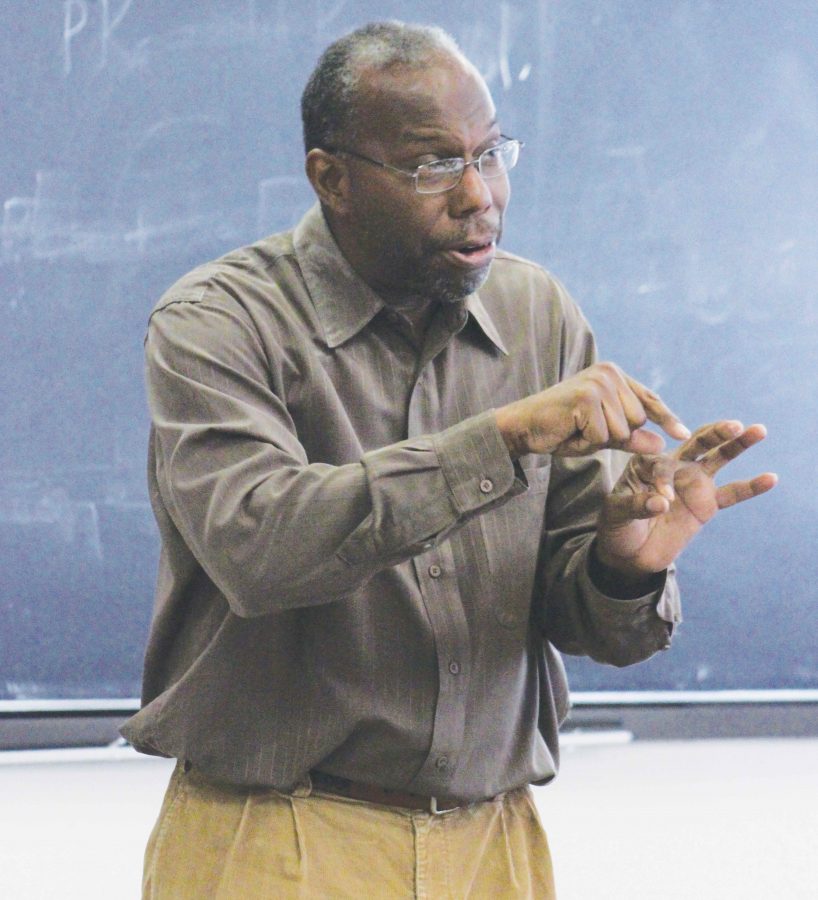Professor Spotlight: Dr. Leroy Peterson
Photo by: Dani Isgett
Dr. Leroy Peterson has raised more than $300,000 in grant money to conduct research with his students.
From a childhood of reading comic books and dreaming of new inventions to teaching at a university and researching co-crystals and photo catalysts, Dr. Leroy Peterson has spent the past 27 years following his dreams of pushing the limits of chemistry and challenging his students to do the same.
Peterson, a Mars Bluff native, developed a passion for creativity and inventing things, while he was in elementary school.
“I was 8 or 9 years old; I used to love reading comic books,” Peterson said. “I couldn’t wait to go to the corner store to pick up a new copy of “Spiderman,” “Hulk” or “Captain America.” We know that comic books are not real, but they kind of get you thinking or imagining about what is possible and what is not possible.”
Peterson said that through reading comic books he not only found a love for pushing the limits but also working in the world of academia.
In addition to comic books, Peterson’s family encouraged him to follow his dream of being a professor and inventor.
“My granddaddy started calling me professor,” Peterson said. “Actually, I started dressing like a professor. I used to wear suits. I would go to the Salvation Army and get stuff and look like a professor from what I thought a professor would look like.”
Peterson said he was not always the best student, but he had a thirst for learning and creativity.
The summer before Peterson’s senior year of high school, he worked in tobacco fields to save up enough money to apply for Clemson University.
“I’ve worked in the tobacco fields all of my life, from seventh grade on through high school,” Peterson said. “The summer between my junior and senior year, I saved money up to apply to Clemson University to get into chemical engineering. I got turned down. I really did want to go there, but they said my SAT scores were not high enough.”
Instead, Peterson went into the military for three years to save up money to go to college.
“I did not really want to go into the military, but I did,” Peterson said. “That was the last place that I wanted to go, but that turned out to be the best thing for me at the time. I learned to push myself physically to the limits.”
After finishing with the Army, Peterson went to Francis Marion College in the spring of 1981.
Peterson completed his chemistry degree in three and a half years and went on to a Ph.D. program at the University of South Carolina. From there, he began teaching at FMU.
Peterson was the first person in his family to go to college.
Peterson said that his love for creativity and chemistry a child has helped him to challenge his students in the lab.
“It is our place to involve students in the research,” Peterson said. “As an undergraduate institution, part of our mission is to train students. I can go into the lab and do it myself probably three or four times faster, but that is not the mission. We not only involve ourselves with research, but we train students to do research.”
Peterson has been working on projects with students involving photocatalysts and co-crystals.
Recently, Peterson worked with chemistry major Macy Barnhill to research how certain photocatalysts are able to clean up waste water. Barnhill presented her research at the National Chemical Society conference in California.
The bulk of Peterson’s research has been spent looking at the molecular structure of crystals.
Eight years ago, Peterson was working on a project with students, looking at the combining Fluorosaccherines with various elements and discovered a bond between two Fluorine atoms that was unheard of.
“At that time, that was the shortest distance between two Fluorine atoms in the literature,” Peterson said. “I spent hours and hours and days and days looking at each of the bond angles and distances in this crystal, and I discovered this short contact between these two Fluorine atoms.”
Peterson said that the research process takes a lot of creativity.
“Sometimes the best discoveries are poured down the drain or thrown in the trash,” Peterson said. “I always tell my students not to throw anything away. We tried to grow crystals; it really looked like junk. We had to go through a whole lot of stuff, and then we go to the microscope, and we see these crystals.”
Peterson is currently working on publishing a paper from that research. He also said he hopes to finish two chemistry papers this summer.
As far as research is concerned, Peterson encourages his students to be creative in their research.
“Except for safety, do not let the book limit what you can do because these books may be obsolete,” Peterson said. “The things in these books may not be valid anymore – a better theory may come along.”
